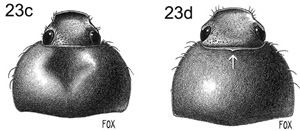| 1. . |
Protibial spur absent (Fig. 10). Maxilla reduced, with 2 or fewer teeth (Fig. 13) | . 2 |
||||||||||||
| 1'. |
Protibial spur present (Fig. 9). Maxilla not reduced, with more than 2 teeth (Figs 11-12, 14) | . 3 |
||||||||||||
|
||||||||||||||
| 2(1). . . . . |
Mesepimeron not visible in dorsal view (e.g., Fig. 6). Clypeus with lateral margins at base straight (forming a right angle with frontoclypeal suture). Maxilla with last segment of palpus 2 times wider than width of third segment (Fig. 13). Dorsal color testaceous | |||||||||||||
| 2'. |
Mesepimeron visible in dorsal view (e.g., Figs 3-5). Clypeus with lateral margins at base oblique (forming an acute angle with frontoclypeal suture). Maxilla with last segment of palpus subequal in width to third segment (Fig. 14). Dorsal color of head, pronotum, and pygidium castaneous with greenish reflections, elytron testaceous with castaneous, longitudinal markings | |||||||||||||
|
||||||||||||||
| 3(1). . |
Labrum projecting anteriorly beyond apex of clypeus (Fig. 15). Apex of labrum deeply emarginate (Figs 15, 18) | |||||||||||||
| 3'. |
Labrum hidden or partially hidden, only apex exposed beyond apex of clypeus (Figs 16, 17). Apex of labrum quadrate, rounded, sinuate (Fig. 19), or emarginate (Fig. 20) | |||||||||||||
|
||||||||||||||
| 4(3). . |
Anterior border of clypeus emarginate, lobed either side of emargination (Fig. 21) | |||||||||||||||||
| 4'. |
Anterior border of clypeus quadrate (Fig. 16), rounded, parabolic (Fig. 17), or produced anteriorly (Figs 22a-b, 23a-c) | . 5 |
||||||||||||||||
|
||||||||||||||||||
| 5(4). . . . . |
Frontoclypeal suture incomplete (obsolete at middle, poorly defined at margin) (Fig. 23a). Sides of clypeus elevated at base of canthus (Fig. 23b). Males with pronotal disc with depression (Figs 23a, 23c). Females with apical margin of pronotum with bead produced posteriorly at middle (V-shaped) (Fig. 23d) | |||||||||
| 5'. |
Frontoclypeal suture complete (Figs 16, 17). Sides of clypeus weakly elevated or flat at base of canthus (Fig. 16). Males with pronotal disc evenly rounded (without fovea). Females with apical margin of pronotum with bead not produced posteriorly | |||||||||
|
||||||||||
6(5). |
Clypeus abruptly reflexed and snout-like, apex abruptly constricted (Figs 22a-b) | |||||||||
| 6'. |
Clypeus not abruptly reflexed and snout-like, apex quadrate, rounded, or parabolic (e.g., Figs 16-17) | . 7 |
||||||||
|
||||||||||
| 7(6). |
Clypeus parabolic (Fig. 17) | |||||
| 7'. |
Clypeus rounded or quadrate (Fig. 16) | |||||
|
||||||
| 8(7). . . |
Pronotum suboval (Fig. 26), with anterior angles not acute (Fig. 31), not covering posterior portion of eye (Fig. 31). Hind wing with region anterior to RA3+4 without setae | |||||||||||||
| 8'. |
Pronotum sub-quadrate (Figs 27, 28), with anterior angles acute (Fig. 32), covering posterior 1/3-1/6 portion of eye (Fig. 32) or pronotum sub-trapezoidal (Fig. 29), with anterior angles not acute, not covering posterior portion of eye. Hind wing with region anterior to RA 3+4 with setae | |||||||||||||
|
||||||||||||||
| 9(8). . |
Mesepimeron partially visible anterior to base of elytron in dorsal view (Figs 3-5) | . 10 |
||||||||
| 9'. |
Mesepimeron concealed by base of elytron in dorsal view (Fig. 6) | |||||||||
|
||||||||||
| 10(9). . |
Base of pronotum tri-emarginate (Fig. 5). Mesometasternum produced anteriorly beyond base of mesocoxae (Fig. 33) | . Popillia |
||||||||||||||||
| 10'. |
Base of pronotum rounded posteriorly (e.g., Figs 26-29). Mesometasternum not produced anteriorly beyond base of mesocoxae (Figs 34, 35) | |||||||||||||||||
|
||||||||||||||||||
| 11(10). . . |
Pronotal surface finely rugopunctate. Elytral surface finely rugopunctate, lacking punctate striae or raised longitudinal ridges | |
| 11'. |
Pronotal surface punctate. Elytral surface with punctate striae, raised longitudinal ridges, or entirely smooth | . 12 |
| 12(11). . . . |
Mesosternal intercoxal region subequal in width to base of mesofemur (Fig. 36). Mesepimeron subrectangular, well-exposed (Fig. 4). Clypeus of male narrowly reflexed at apex. Dorsal surface of elytron flat | |||||||||
| 12'. |
Mesosternal intercoxal region less than 1/4 width of base of mesofemur (Fig. 35). Mesepimeron subtriangular, partially exposed (Fig. 3). Clypeus of male broadly reflexed at apex. Dorsal surface of elytron evenly rounded | |||||||||
|
||||||||||
| 13(9). . . . |
Mesosternal intercoxal region subequal in width to base of mesofemur or 1/2 width of base of mesofemur (Fig. 37). Mesometasternum produced anteriorly beyond base of mesocoxae (Fig. 37) | |||||
| 13'. |
Mesosternal intercoxal region less than 1/4 width base of mesofemur (Fig. 34). Mesometasternum not produced anteriorly beyond base of mesocoxae (Fig. 34) | |||||
|
||||||
| 14(13). . |
Height of clypeal apex in frontal view about 1/2 length of clypeus in dorsal view (Fig. 24). Maxilla with 5 teeth | . Nayarita |
||||
| 14'. |
Height of clypeal apex in frontal view about 1/3-1/4 length of clypeus in dorsal view (Fig. 25). Maxilla with 6 teeth | . 15 |
||||
|
||||||
| 15(14). . |
Last abdominal spiracle tuberculiform in male (Fig. 38). Pronotum with apical margin not beaded | |||||
| 15'. |
Last abdominal spiracle simple, not tuberculiform in male or female (Fig. 39). Pronotum with apical margin beaded | |||||
|
||||||


































